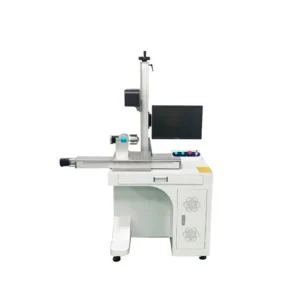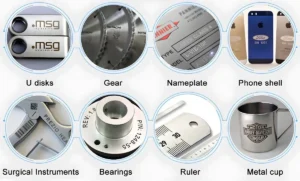Introduction:
Barcodes are a great way to create web links or product information. A weblink might include all the information about a product, including compliance information and instructions for using the product or its warranty. Therefore, it is an easy and efficient way to help customers identify your product. A laser marking machine, in this case, can help you a lot when marking barcodes on your products.
You can mark barcodes in several ways. The two methods include dot peening and laser marking. However, a laser marking machine is the best way to create barcodes today. There’s no limitation on products. You can laser mark barcodes on many materials as well. In this case, dot peening lacks a lot.
Therefore, laser marking is handy for a reliable barcode marking method. Choosing the correct method makes all the difference in manufacturing or logistics. Barcode laser marking offers the durability and quality that modern industries always demand.
What Is a Barcode?
A barcode is a visual pattern that represents data. Many types of barcodes exist, including lines, shapes, and dots. Whatever the type, you can simply read it using a scanner on your phone or special devices.
There are several types of barcodes, with two main types: linear and two-dimensional. Linear barcodes are the traditional barcodes we see everywhere. They usually have two vertical lines and store data in one direction.
On the other hand, 2D barcodes contain limited information. They are usually labeled with graphics such as QR codes or data matrix codes. People commonly use them to track and store products.
Role of Barcodes
Barcodes have revolutionized how we deal with stocks and keep track of products. Suppose a retail shop has tens of thousands of items in its assortment. Tracking each one by hand would be a tall order. But with a barcode, it’s a snap. You can simply scan the barcode links to a database or reveal real-time information. This accelerates sales and inventory processes, as well. Also, it eliminates errors that often come from manual tracking.
Most companies use barcodes to track items in transit. This way, they ensure product handling is accurate.
Ways of Marking Barcode on Products
Marking barcodes on products can generally be done in several ways. Not all methods offer benefits; they also have limitations. That’s why new and efficient technologies appear.
Inkjet Printing
Inkjet printing is widely used for barcodes. This method uses droplets of ink ejected on a surface to form a barcode. If you’re wondering what makes it so great, it is fast, and you can apply it to any material, including paper, plastic, and leather. However, with time, the barcodes printed with the help of an inkjet printer may distort or blur.
Labeling
Another method is labeling. Adhesive labels are straightforward ways to apply barcodes. You simply stick them on the product. It sounds easy and cheap, but there are a few catches. It is seen that labels can easily peel off. It mostly happens when the product is exposed to harsh conditions.
Dot Peening Machine
Dot peening takes a different approach. This method uses a metallic pen to hit the part. The impulse force typically creates the groove on the product’s surface, creating text and barcodes. However, this method is restricted to simple texts and designs and applies to hard materials only.
Laser Marking Machine

Finally, we have laser marking. This is where the magic happens. Laser marking is a method of generating a barcode by accommodating a beam of light. Laser etch QR code is known for precision and durability. Unlike inkjet or labeling, laser marking doesn’t fade or peel. Laser marking can also be done on other surfaces of an object; it does not necessarily have to be metal alone.
What Is Laser Marking for Barcodes?
Laser marking is an accurate approach to labeling barcodes. When light is focused on objects, it creates marks on them, which can be permanent. Because a laser marking machine is quick and efficient, people frequently use it to create products’ barcodes. There are different ways to use a laser to mark things.
A laser engraver removes material to make a deep mark. Meanwhile, annealing alters a material’s color without affecting the layer. This type of barcode marking is ideal for marking metals.
Ablation is another favorite. This method can only be performed on coated objects. It removes the coatings from the object and reveals the material underneath.
Laser foaming is a trendy method for marking plastic. In this method, a focused laser beam creates foam under the plastic layer.

Each of these methods works well for barcodes. However, one method’s limitations are another’s strengths. So, the choice will depend on your project material and desired outcome.
A laser marking machine can mark many different objects. It can do this work on metals, plastics, or even leather. Popular metals used in this case are aluminum and stainless steel. They typically respond well to laser marking, making the barcodes clear and long-lasting.
Why Choose a Laser Marking Machine for Barcode Applications?
If you are looking for a barcode marking, you must focus on precision and quality. As you know, each dot line or pattern in a barcode represents some number letters or links. So, the precision is a crucial factor here. And laser marking machines can guarantee that precision.
Laser marking machines create barcodes that are sharp, clear, and high-contrast. This means scanners can easily read them, no matter the conditions.
Reason #1 Precision
Have you ever dealt with a damaged label? If so, you may understand how important it is to ensure the quality of the markings. That fear is no longer an issue because of laser branding. You may carefully laser etch QR codes to ensure they stand out and meet the most stringent requirements.
Reason #2 Durability
Unlike labeling or inkjet printing, laser marking is a very effective process. You can test it yourself. Take a scrap of the part and mark a barcode on it. You can try scratching it to remove the markings. By the end, you will find it difficult to remove the markings.
These marks resist fading, scratching, and chemical exposure. Overall, this method creates a very durable mark.
Reason #3 Speed and Efficiency
Laser marking works with the help of light. You can imagine the speed of light. It can complete an hour’s job in a few seconds. Besides, the laser hits exactly the place you need it to hit. As a result, you can get a very precise result.
Reason #4 Environmental Benefits
Laser marking is 100% environmentally friendly. It is a clean and non-contact process. Unlike traditional methods, they do not use inks or chemicals. So, it’s safe to use and green for the environment.
How Does Barcode Laser Marking Work?
Like other laser marking processes, barcode laser marking works by combining laser technology with precision marking features.
Step #1 Laser Selection and Settings
At the very first step, you must determine what type of laser you need. What material are you going to work with? The answer is typically the guide to your choice.
For example, a fiber laser is excellent for working with metals. Note that a CO2 laser can not be metal, but you could use a CO2 laser for the ablation process. You can also choose a UV or diode laser to mark different objects.
After you have chosen the right option, you can set up the system correctly. When setting up your device, you must focus on calibration. You can get the best marking if you put the laser gun at an appropriate distance. You can just follow the user manual that comes with your device.
Step #2 Barcode Design and Input
Once the laser is selected, it’s time to design the barcode. Most laser marking machines come with user-friendly software. You can easily input the barcode data here. Whether it’s numbers, letters, or a QR code, the software handles it. You can even adjust the size and format to fit your product. It’s like setting the stage for a performance. The better the design, the clearer the barcode will be.
Step #3 Marking Process
Once you are ready, you can start the laser marking machine and observe the marking process. Technically, this step is very fast. Completing a mark on a medium-sized product takes only a few seconds. You may wonder how it stays so precise. The machine automatically adjusts the laser power and speed, ensuring a high-quality mark every time.
Benefits of Owning a ZLTECH Laser Marking Machine
When it comes to laser marking, ZLTECH machines stand out. ZLTECH laser marking machines are known for their fast marking, quality, and international recognition. Why you should own a ZTECH laser marking machine? Check out the following few reasons.
Advanced Technology
One of the biggest advantages of using a ZLTECH Laser Marking Machine is its technology. You will be surprised to know that each part used in these machines is the latest. This means you can enjoy more features and quality options. So, these machines are highly adaptable.
Versatile Applications
As mentioned before, these QR code laser marking machines are very adaptable. This means you can do a lot of different tasks using one machine. Also, you can work with a wide range of materials.
Durability and Reliability
Reliability is crucial in today’s fast-paced world. ZLTECH tools are made to last and can work in high-demand places.
Ease of Use
ZLTECH laser marking machine comes with a user-friendly interface. You can choose from 20+ languages. You can also read the user manual to set up the device perfectly. If you need any assistance, you can get the quickest response from their customer service team.
Cost-Effectiveness
ZLTECH barcode laser marking machine offers low initial and operating costs. It doesn’t need much maintenance, saving a significant investment. Replacement parts are also available at any local market.
Get in Touch with Us!
If you have any questions, contact our customer support team. Whether you are looking for a barcode laser marking machine or other laser devices, this is the right place.
